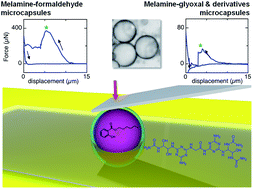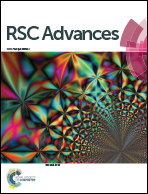Formaldehyde-free melamine microcapsules as core/shell delivery systems for encapsulation of volatile active ingredients†
Abstract
The release of volatile bioactive molecules, such as fragrances, can be controlled by microencapsulation in core–shell polymeric delivery systems. Currently, most of the available polymers are based on melamine–formaldehyde materials, and the release is generally triggered by the rupture of the brittle and stiff shell. However, formaldehyde-based chemistry may often be undesirable in applications for consumer goods such as personal care products or detergents for fabrics, and there is a strong need for formaldehyde-free microcapsules in these applications. In this article, formaldehyde is successfully substituted by glyoxal and its derivatives to allow the polymerization of melamine and other amines to prepare oligomers as starting point for core/shell polymerization. The oligomer synthesis is optimized via the reactant composition and towards an enhanced potential cross-linking density. The formulations with the most branched oligomers are applied at the interface of oil-in-water emulsions to prepare microcapsules. Their capacity to retain volatile molecules is measured by thermogravimetry and their mechanical properties are measured by micromechanical testing using compression–retraction cycles on multiple individual microcapsules. The results reveal an excellent retention capacity for volatile molecules and tunable mechanical properties that make these capsules highly suitable as a formaldehyde-free alternative to conventional aminoplast microcapsules.



 Please wait while we load your content...
Please wait while we load your content...